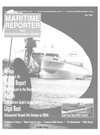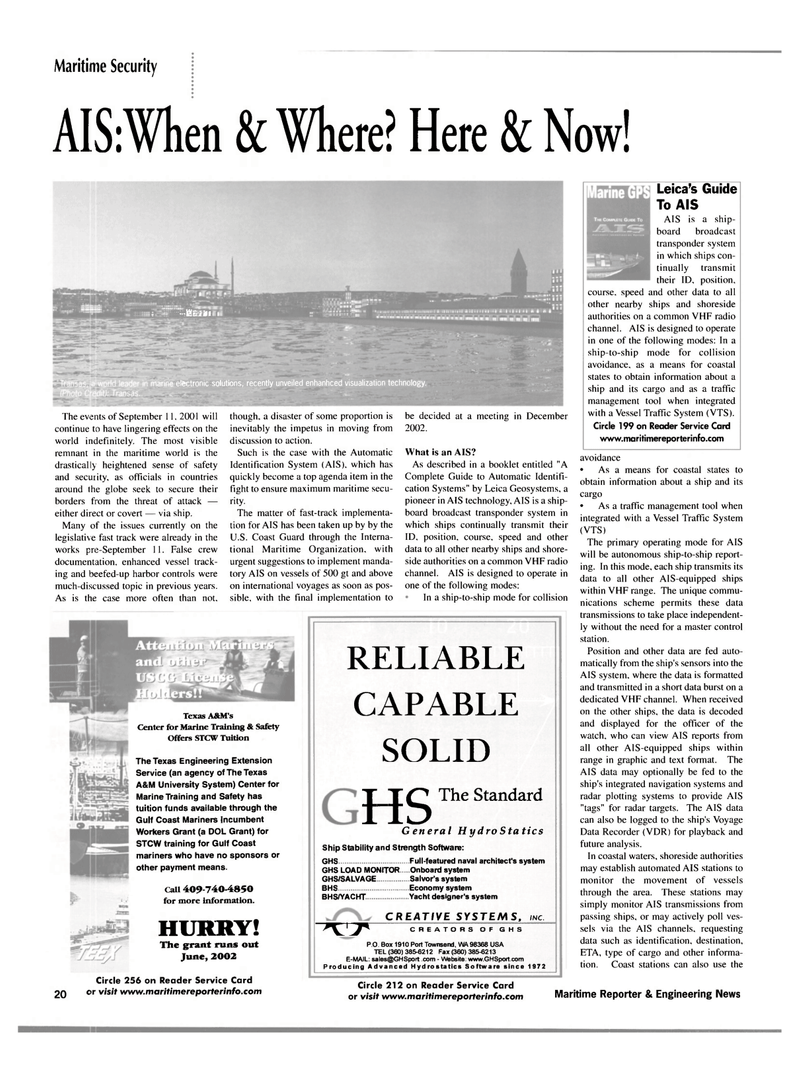
Page 20: of Maritime Reporter Magazine (May 2002)
Read this page in Pdf, Flash or Html5 edition of May 2002 Maritime Reporter Magazine
Maritime Security
AIS:When & Where? Here & Now!
Leica's Guide
To AIS
AIS is a ship- board broadcast transponder system in which ships con- tinually transmit their ID, position, course, speed and other data to all other nearby ships and shoreside authorities on a common VHF radio channel. AIS is designed to operate in one of the following modes: In a ship-to-ship mode for collision avoidance, as a means for coastal states to obtain information about a ship and its cargo and as a traffic management tool when integrated with a Vessel Traffic System (VTS).
Circle 199 on Reader Service Card www.maritimereporterinfo.com
HURRY!
The grant runs out
June, 2002 20
Circle 256 on Reader Service Card or visit www.maritimereporterinfo.com
RELIABLE
CAPABLE
SOLID
J J g The Standard
General Hydrostatics
Ship Stability and Strength Software:
GHS Full-featured naval architect's system
GHS LOAD MONITOR Onboard system
GHS/SALVAGE Salvor's system
BHS Economy system
BHS/YACHT. Yacht designer's system
CREATIVE SYSTEMS, INC. ^ CREATORS OF GHS
P.0 Box 1910 Port Townsend, WA 98368 USA
TEL (360) 38S6212 Fax (360) 385-6213
E-MAIL: sales@GHSport com - Website: www.GHSport.com
Producing Advanced Hydrostatics Software since 1972
Circle 212 on Reader Service Card or visit www.maritimereporterinfo.com avoidance • As a means for coastal states to obtain information about a ship and its cargo • As a traffic management tool when integrated with a Vessel Traffic System (VTS)
The primary operating mode for AIS will be autonomous ship-to-ship report- ing. In this mode, each ship transmits its data to all other AlS-equipped ships within VHF range. The unique commu- nications scheme permits these data transmissions to take place independent- ly without the need for a master control station.
Position and other data are fed auto- matically from the ship's sensors into the
AIS system, where the data is formatted and transmitted in a short data burst on a dedicated VHF channel. When received on the other ships, the data is decoded and displayed for the officer of the watch, who can view AIS reports from all other AlS-equipped ships within range in graphic and text format. The
AIS data may optionally be fed to the ship's integrated navigation systems and radar plotting systems to provide AIS "tags" for radar targets. The AIS data can also be logged to the ship's Voyage
Data Recorder (VDR) for playback and future analysis.
In coastal waters, shoreside authorities may establish automated AIS stations to monitor the movement of vessels through the area. These stations may simply monitor AIS transmissions from passing ships, or may actively poll ves- sels via the AIS channels, requesting data such as identification, destination,
ETA, type of cargo and other informa- tion. Coast stations can also use the
Maritime Reporter & Engineering News $•--•"-BSitil
The events of September 11. 2001 will continue to have lingering effects on the world indefinitely. The most visible remnant in the maritime world is the drastically heightened sense of safety and security, as officials in countries around the globe seek to secure their borders from the threat of attack — either direct or covert — via ship.
Many of the issues currently on the legislative fast track were already in the works pre-September 11. False crew documentation, enhanced vessel track- ing and beefed-up harbor controls were much-discussed topic in previous years.
As is the case more often than not. electronic solutions, recently unveiled enhanhced visualization technology. though, a disaster of some proportion is inevitably the impetus in moving from discussion to action.
Such is the case with the Automatic
Identification System (AIS). which has quickly become a top agenda item in the fight to ensure maximum maritime secu- rity.
The matter of fast-track implementa- tion for AIS has been taken up by by the
U.S. Coast Guard through the Interna- tional Maritime Organization, with urgent suggestions to implement manda- tory AIS on vessels of 500 gt and above on international voyages as soon as pos- sible, with the final implementation to be decided at a meeting in December 2002.
What is an AIS?
As described in a booklet entitled "A
Complete Guide to Automatic Identifi- cation Systems" by Leica Geosystems, a pioneer in AIS technology, AIS is a ship- board broadcast transponder system in which ships continually transmit their
ID. position, course, speed and other data to all other nearby ships and shore- side authorities on a common VHF radio channel. AIS is designed to operate in one of the following modes:
In a ship-to-ship mode for collision
Texas A&M's
Center for Marine Training & Safety
Offers STCW Tuition
Call 409-740-4850 for more information.
The Texas Engineering Extension
Service (an agency of The Texas
A&M University System) Center for
Marine Training and Safety has tuition funds available through the
Gulf Coast Mariners Incumbent
Workers Grant (a DOL Grant) for
STCW training for Gulf Coast mariners who have no sponsors or other payment means.

 19
19

 21
21
